Can you Recognize if the Chicken is Spoiled?
Chicken, a staple in cuisines worldwide, stands as a versatile protein source loved for its adaptability in various recipes. From succulent roasts to savory stir-fries, chicken finds its way onto dinner plates across cultures. However, amidst the culinary delights, lies the responsibility of ensuring the chicken’s freshness and safety. Recognizing the signs that chicken is spoiled is paramount to prevent foodborne illnesses and maintain a healthy lifestyle. In this extensive guide, we delve into the nuances of identifying spoiled chicken in its various forms: raw, frozen, cooked, and packaged, equipping you with the knowledge to make informed decisions about the chicken you consume.
How to Tell if Raw Chicken is Bad:
- Appearance:
- Texture:
- Smell:
- Expiration Date:
Freshness begins with the eyes. When inspecting raw chicken, observe its color closely. Fresh chicken typically exhibits a pinkish hue, indicating its youthfulness and quality. However, if the chicken appears discolored with gray or greenish patches, it’s a red flag signaling potential spoilage.
Texture provides valuable insights into the chicken’s condition. Run your fingers over the chicken’s surface, feeling for moisture and suppleness. Fresh chicken should feel slightly moist and slippery, a testament to its freshness. Conversely, if the chicken feels slimy or has a sticky texture, it’s likely spoiled and best avoided.
The olfactory senses play a crucial role in detecting spoiled chicken. Lean in and take a whiff of the chicken’s aroma. Fresh chicken should emit a neutral or faintly meaty smell, indicative of its pristine state. However, a pungent or foul odor emanating from the chicken signals spoilage and warrants immediate disposal.
While not foolproof, checking the expiration or “sell by” date on the packaging provides a helpful reference point. However, it’s essential to remember that expiration dates are guidelines and may not always accurately reflect the chicken’s freshness. Therefore, inspecting the chicken’s condition using other methods is equally crucial.
How to Tell if Frozen Raw Chicken is Spoiled:
- Ice Crystals:
- Color Changes:
- Odor:
- Texture:
Frozen chicken should be a sight to behold – pristine and encased in ice. However, excessive ice crystals or signs of freezer burn mar its appearance, indicating potential deterioration in quality. When thawed, these areas may appear discolored and compromise the chicken’s taste and texture.
Frozen chicken retains its color relatively well, but prolonged freezing can lead to discoloration. Watch out for gray spots or patches, as they signal freezer burn and potential spoilage. Additionally, any drastic changes in color from pink to gray warrant careful inspection.
Despite being frozen, spoiled chicken may release odors once thawed. After defrosting the chicken, take a moment to assess its smell. A strong, unpleasant odor suggests spoilage and necessitates discarding the chicken to prevent foodborne illnesses.
Texture evaluation is crucial post-thawing. Freshly thawed chicken should feel firm and pliable. Any sliminess or mushiness indicates spoilage and renders the chicken unfit for consumption.
How to Tell if Cooked Chicken is Spoiled:
- Appearance:
- Smell:
- Texture:
- Storage Time:
Cooked chicken should present itself with uniformity – in color, texture, and appearance. Inspect the chicken closely for any signs of discoloration, such as dark spots or an unnatural sheen, as they may indicate spoilage.
Spoilage doesn’t spare cooked chicken. When assessing its freshness, rely on your sense of smell. Cooked chicken should not emit any strong or off-putting odors. A sour or rancid smell is a clear indicator of spoilage and warrants immediate disposal.
Texture can reveal much about the chicken’s condition post-cooking. Properly cooked chicken should be tender and juicy, inviting you to savor each bite. However, if the texture feels dry, rubbery, or excessively mushy, it’s a telltale sign of spoilage and calls for caution.
Time is of the essence when it comes to cooked chicken. Refrigerate leftovers promptly and consume them within 3-4 days to ensure freshness and safety. Extended storage or leaving cooked chicken at room temperature for prolonged periods increases the risk of spoilage and foodborne illnesses.
How to Tell if Packaged Chicken is Spoiled:
- Packaging Condition:
- Expiration Date:
- Odor:
- Appearance:
The packaging serves as the chicken’s shield against external contaminants. Inspect it closely for any tears, leaks, or bulges, as they compromise the chicken’s freshness and safety. Damaged packaging is a red flag indicating potential spoilage and should be avoided.
Manufacturers provide expiration dates as a guideline for consumers. While helpful, it’s essential to corroborate the chicken’s freshness through other means. Nonetheless, paying attention to the expiration date can offer valuable insights into the chicken’s shelf life and quality.
Unwrapping the package unveils the chicken’s essence. Take a moment to inhale and assess its aroma. Any unusual or foul odors emanating from the chicken signal spoilage and necessitate immediate action to prevent foodborne illnesses.
Visual inspection is key when evaluating packaged chicken. Assess its color, ensuring it’s consistent throughout and free of any abnormal spots or discoloration. Any deviations from the norm indicate potential spoilage and warrant caution.
Conclusion:
Safeguarding against spoiled chicken is essential for preserving health and enjoying wholesome meals. By familiarizing yourself with the signs of spoilage in raw, frozen, cooked, and packaged chicken, you can confidently assess its freshness and make informed decisions. Trust your senses, adhere to proper storage practices, and prioritize food safety at all times. With diligence and attention to detail, you can savor delicious chicken dishes with peace of mind, knowing they’re safe and wholesome.
I hope you liked this article that we offer to help you easily spot spoiled chicken. You can search our website to find other useful information about food or review the “food” section of the site. ■



